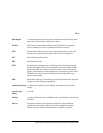
GL–12 Glossary
protocol The conventions or rules for the format and timing of messages sent and
received.
PTL Port-Target-LUN. The controller’s method of locating a device on the
controller’s device bus.
PVA module Power Verification and Addressing module.
RAID Redundant Array of Independent Disks. Represents multiple levels of
storage access developed to improve performance or availability or both.
RAID level 0 A RAID storageset that stripes data across an array of disk drives. A single
logical disk spans multiple physical disks, allowing parallel data processing
for increased I/O performance. While the performance characteristics of
RAID level 0 are excellent, this RAID level is the only one that does not
provide redundancy. Raid level 0 storagesets are sometimes referred to as
stripesets.
RAID level 0+1 A RAID storageset that stripes data across an array of disks (RAID level 0)
and mirrors the striped data (RAID level 1) to provide high I/O performance
and high availability. Raid level 0+1 storagesets are sometimes referred to as
striped mirrorsets.
RAID level 1 A RAID storageset of two or more physical disks that maintains a complete
and independent copy of the entire virtual disk's data. This type of storageset
has the advantage of being highly reliable and extremely tolerant of device
failure. Raid level 1 storagesets are sometimes referred to as mirrorsets.
RAID level 3 A RAID storageset that transfers data parallel across the array’s disk drives a
byte at a time, causing individual blocks of data to be spread over several
disks serving as one enormous virtual disk. A separate redundant check disk
for the entire array stores parity on a dedicated disk drive within the
storageset. See also RAID level 5.
RAID Level 5 A RAID storageset that, unlike RAID level 3, stores the parity information
across all of the disk drives within the storageset. See also RAID level 3.


















